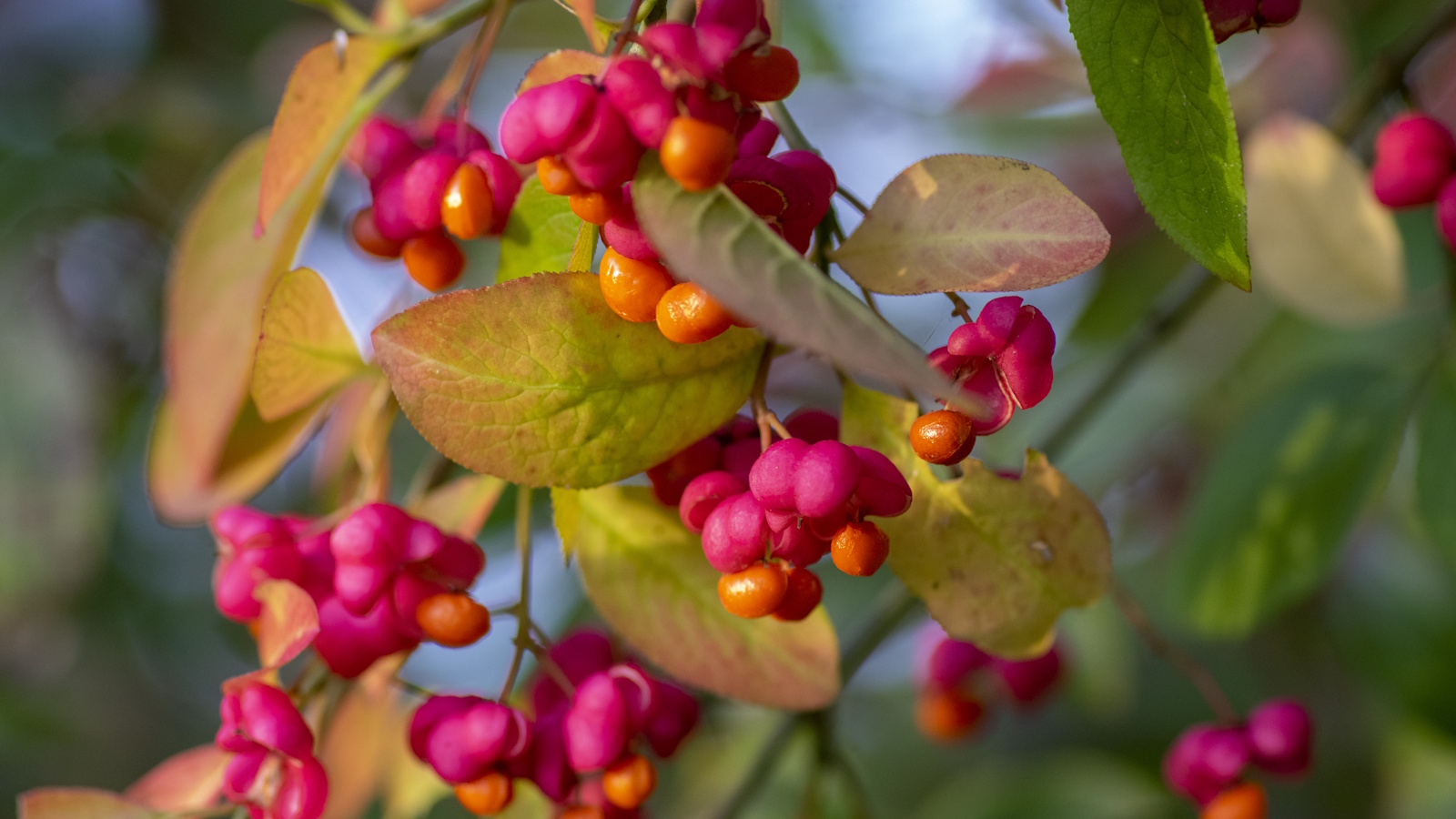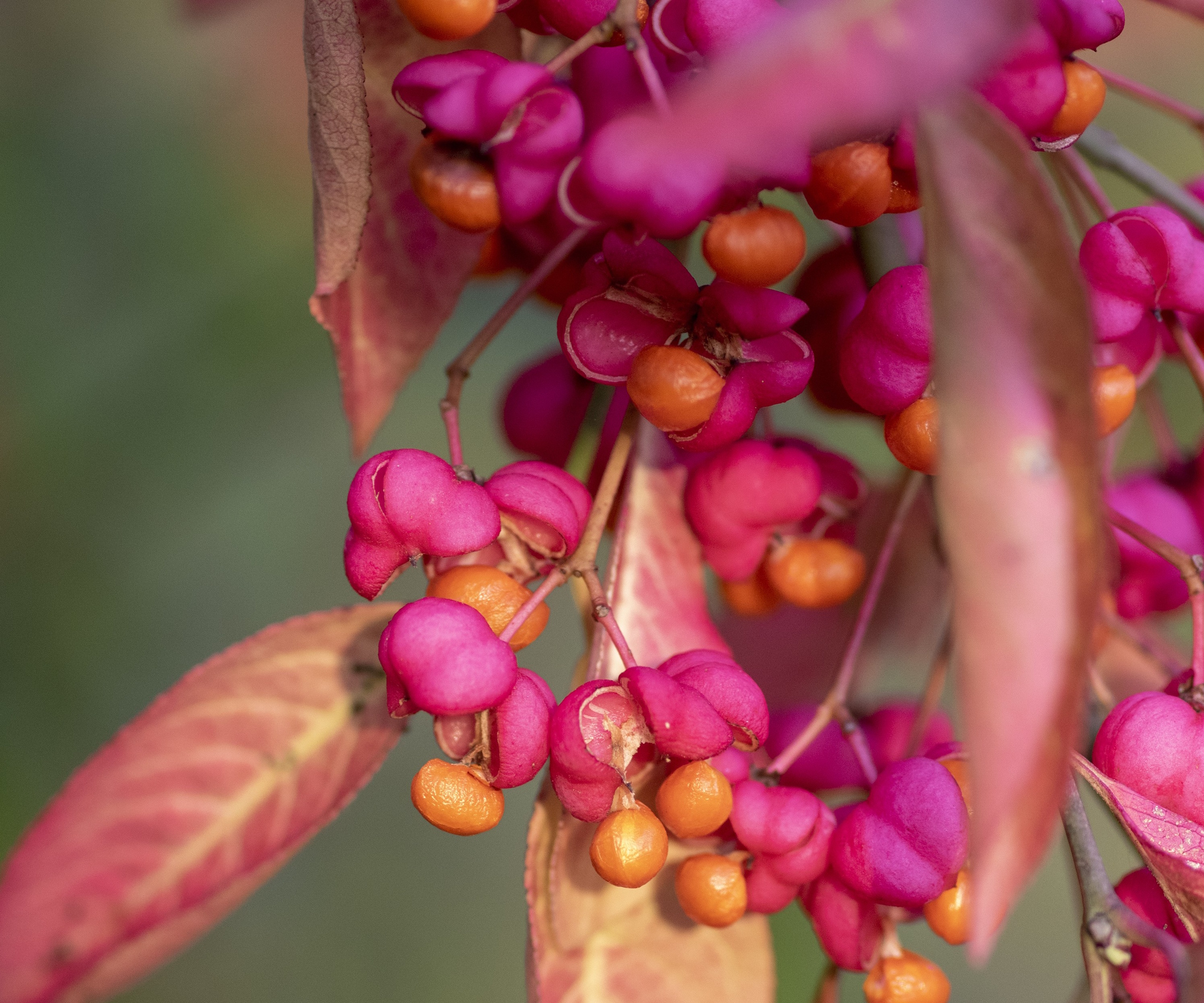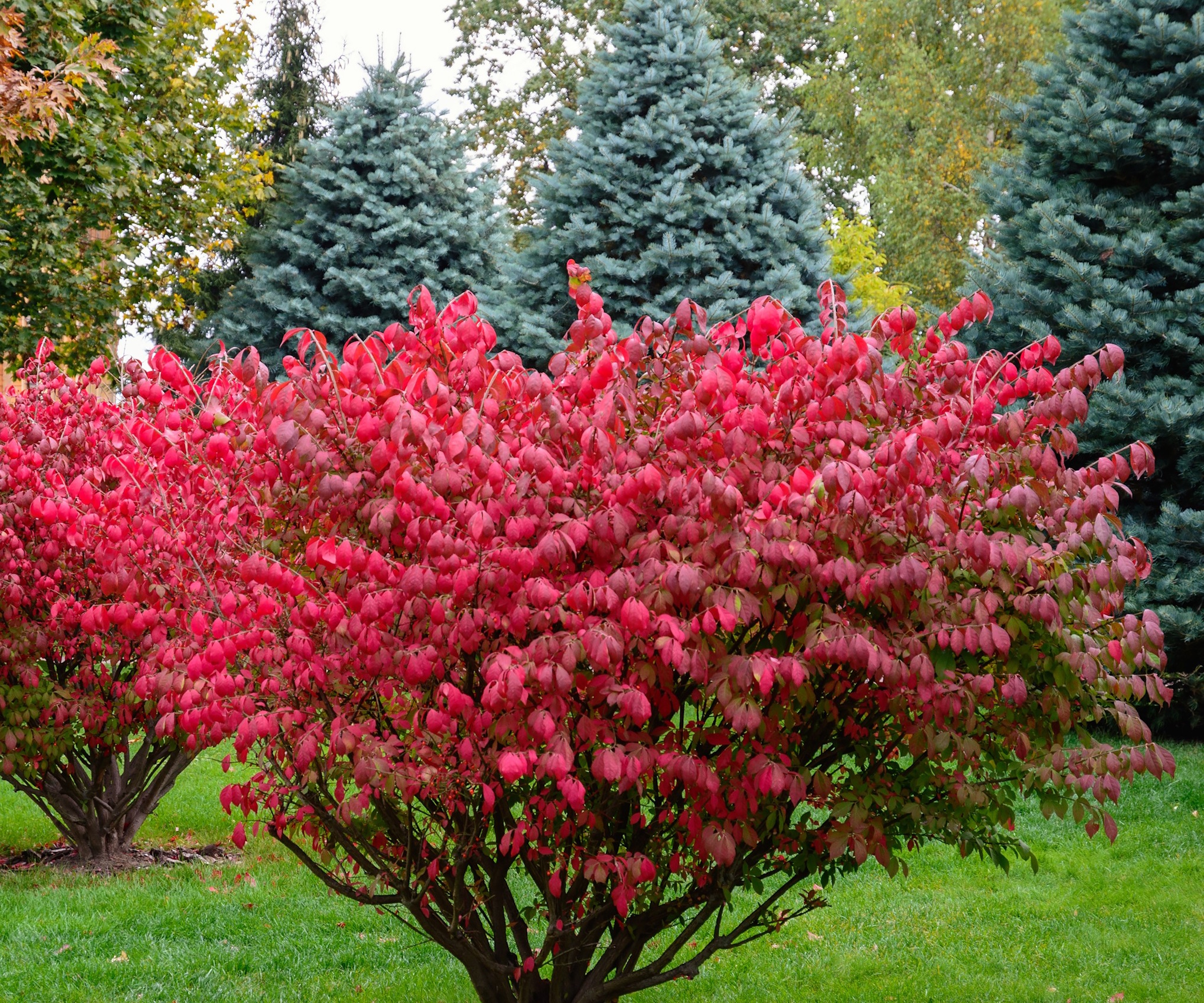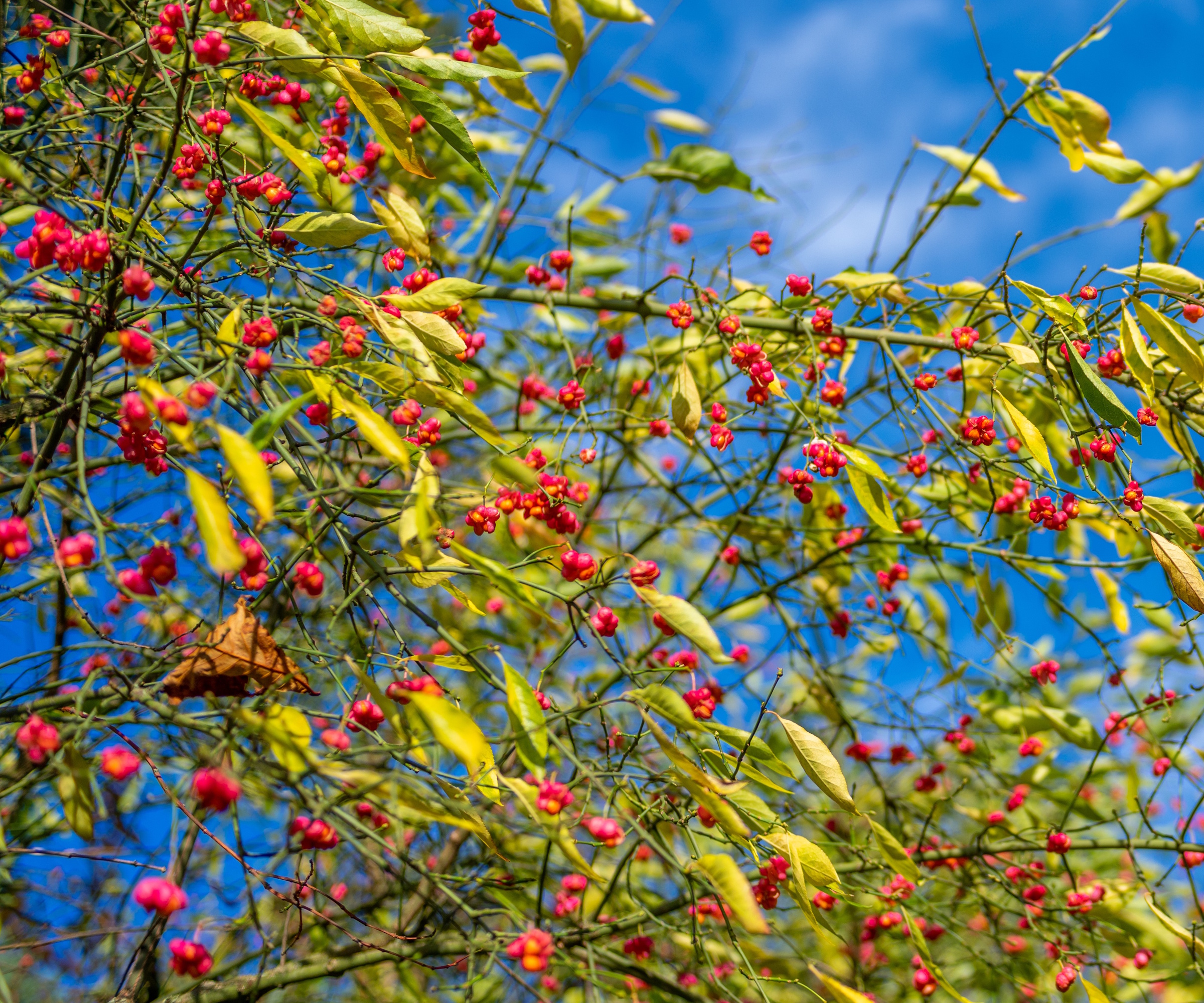
European spindle trees, Euonymus europaeus, are low-maintenance, small trees native to much of northern and central Europe. These deciduous trees often grow at the edge of woodlands and forests, bearing attractive oval-shaped leaves that turn impressive shades of crimson and orange during early fall.
It is the seed capsules, however, that are the real stars of the show, ripening to magenta in October and November before splitting open to reveal fluorescent orange seeds, as seen in the images here. If you are looking for an intense, firework-like display, learning how to grow spindle trees is a good idea.
While spindle trees are part of the same plant family as burning bush shrubs, Euonymus alatus, they are far less vigorous. Burning bush shrubs have become naturalized in over 20 states and are classified as invasive in many of them. So, if you are looking for some of the best euonomous trees or best statement trees with striking foliage and vibrant seedpods, my advice is to grow spindle trees instead of burning bush. Here, experts reveal how best to grow this unique species.

How to grow spindle trees
As the growing season comes to an end, there is nothing better than marking this seasonal change with vibrant shades of orange, yellow, red and purple helping to ease the transition to the colder months of the year. So, while there are many trees for small gardens to choose from, learning how to grow spindle trees will help make the most of your garden, whatever the time of year.
Growing advice for spindle trees

If you are looking for colorful backyard ideas, or perhaps you are wondering how to choose a tree that will add impact to your borders and pot displays, growing a spindle tree should be a consideration.
'Spindle trees are fabulously flamboyant and sure to turn heads,' says plant expert, Katie Sunderlage. 'They are winter hardy from US hardiness zone 3 to US hardiness zone 8, tolerating cold weather and frost just fine.
'If you have a small plot, spindle trees can be successfully grown in pots,' Katie adds, 'although their growth will be limited by the size of your container. If you do opt to grow in a pot, it's important to choose one that is large enough to accommodate the entire root system and allow room for growth too. The pot should have good drainage and an all-purpose potting mix should be used for best results,' Katie continues.
In the US, European spindle trees can be hard to come by, so check with your local nursery to ascertain availability. Alternatively, try growing this small tree from seed, which can be sown during late winter. The seeds require a cold period of stratification, so if you are growing this way, sow when the weather is still relatively chilly.
European spindle tree seeds can be ordered online from Walmart.
How to care for spindle trees

Soil: 'Spindle trees prefer evenly moist but well-drained soil,' Katie says. 'If your soil is relatively free-draining, mulching can help retain moisture.' Consider applying pine straw mulch, available from Walmart, or homemade organic matter from your compost heap, which will improve soil health, suppress weeds and retain water during the summer months.
Light: 'For the best display of the fruits and seeds in the fall and winter months, it’s best to grow the spindle trees in full to part sun,' Katie advises. Position your tree in a spot with at least four hours of sunlight, but preferably six hours or more, which will ensure that you enjoy masses of seedpods come fall.
Watering: After planting, it is best to deeply water every other week during the first year while your tree settles into your yard. During periods of warm weather, you might need to increase the frequency of watering. In addition, when growing in pots, be sure to monitor the soil frequently during the spring and summer, watering when the top two inches are dry.
Fertilizing: 'Fertilizing isn’t necessary if your soil is rich in nutrients,' Katie says. 'If you are worried that your soil is too free-draining or low in nutrients, remember to mulch in the fall, but you can also apply an all-purpose, slow-release plant food in the spring. Organic fertilizers that can be used for spindle trees are available from Amazon.
Pruning: 'In late winter or early spring, prune off any damaged or dead branches to divert more energy into new growth,' Katie adds. 'You can also remove any crossing branches to reduce congestion and allow for airflow in the middle of the tree, which will help to limit the spread of infection and disease.' Pruning snips are available from Amazon.
Toxicity: All parts of the spindle tree are considered toxic to humans and animals. The fruit is poisonous and contains alkaloids that can cause harm to young children and pets who might be attracted to the brightly colored seedpods.
FAQs
What is the difference between a spindle tree and a burning bush tree?
While both are in the Euonymus genus, there are key differences to observe between a spindle tree and a burning bush tree. 'Burning bush, Euonymus alatus, is a bit of a problem for us in North America,' says Bert Bast, garden expert and owner of Bast Brothers Garden Center. 'They are invasive plants that have been known to completely take over unmaintained wooded areas forcing out the native plants that would typically live in that area.
'Burning bush trees are currently banned in Delaware, New York, and Pennsylvania and there is legislation in the works to ban them here in New Jersey. The European spindle tree, Euonymus europaeus, is a versatile and far less vigorous tree,' Bert adds, 'that tends to reach 10-20 feet tall compared with the smaller burning bush, which might only reach 10 feet.'
So, while they might look similar, burning bush is to be avoided in the US, as it can quickly spread and take over.
Do I need to winterize spindle trees?
No, spindle trees are fully winter hardy, tolerating cold snow and frost in US hardiness zone 3 plus. However, if you grow spindle trees in containers, 'it is a good idea to place the pot in a protected area during the winter months,' Katie Sunderlage says. 'The soil in your pots will freeze far more easily than in your borders, so in cooler, northerly locations, keep an eye on your containers.'
Is the Korean spindle tree a good choice for a small backyard?
The Korean spindle tree, Euonymus oxyphyllus, is a species of flowering plant in the same family as the burning bush shrub and the European spindle tree. This species is native to China, North and South Korea and Japan, growing best from US hardiness zone 4 plus. It reaches up to eight feet tall, making it a good choice for a small yard. What's more, the Korean spindle tree also displays remarkable fall foliage and fruits, and it is not considered invasive.
While fall is a wonderful time for the spindle tree, this is also one of the best trees for wildlife at all times of year. In spring, the flowers are a rich source of nectar and pollen for insects, while the leaves are eaten by many different species of moths, including the spindle moth and magpie moth. So, if you are keen to invite pollinators to your plot, the spindle tree is a good species to plant this year.







